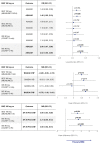Matching-Adjusted Indirect Comparison of the 52-Week Efficacy of Bimekizumab Versus Secukinumab and Ixekizumab for the Treatment of Radiographic Axial Spondyloarthritis
- PMID: 38916823
- PMCID: PMC11265043
- DOI: 10.1007/s40744-024-00684-z
Matching-Adjusted Indirect Comparison of the 52-Week Efficacy of Bimekizumab Versus Secukinumab and Ixekizumab for the Treatment of Radiographic Axial Spondyloarthritis
Abstract
Introduction: A previous network meta-analysis established 16-week relative efficacy with bimekizumab, an inhibitor of interleukin (IL)-17F in addition to IL-17A, versus other treatments for patients with radiographic axial spondyloarthritis (r-axSpA; i.e., ankylosing spondylitis), including the IL-17A inhibitors secukinumab and ixekizumab. This matching-adjusted indirect comparison (MAIC) assessed 52-week relative efficacy of bimekizumab versus secukinumab and ixekizumab.
Methods: Individual patient data from BE MOBILE 2 (bimekizumab 160 mg; N = 220) were matched to pooled summary data from MEASURE 1/2/3/4 (secukinumab 150 mg), MEASURE 3 (secukinumab 300 mg; escalated dose for inadequate responders), COAST-V (ixekizumab) and COAST-V/-W (ixekizumab). BE MOBILE 2 patients were reweighted using propensity score weights based on age, sex, ethnicity, tumor necrosis factor inhibitor (TNFi) exposure, weight, baseline ASDAS and BASFI (secukinumab) and baseline BASDAI (ixekizumab), and 52-week efficacy outcomes from the trial recalculated. Odds ratios (OR) or mean difference for unanchored comparisons are reported with 95% confidence intervals (CI).
Results: At week 52, MAIC demonstrated that patients may have higher likelihood of improvement in key efficacy outcomes with bimekizumab versus secukinumab 150 mg (e.g., ASAS40: [OR (95% CI): 1.48 (1.05, 2.10); p = 0.026]; effective sample size [ESS] = 177). Differences in 52-week efficacy outcomes between bimekizumab and secukinumab 300 mg dose escalation were non-significant (ESS = 120). Bimekizumab versus ixekizumab 80 mg comparisons (COAST-V only; ESS = 84) also suggested that differences were non-significant for most key efficacy outcomes. Other ixekizumab comparisons (COAST-V/-W; ESS = 45) suggested bimekizumab may have higher comparative efficacy for many of the same efficacy outcomes, however ixekizumab analyses were limited by poor population overlap, likely due to the greater proportion of patients with previous TNFi exposure.
Conclusions: Patients treated with bimekizumab may have a higher likelihood of achieving improved longer-term efficacy versus secukinumab 150 mg, suggesting bimekizumab may be a favorable therapeutic option for r-axSpA. Differences in efficacy outcomes with bimekizumab versus ixekizumab 80 mg were mostly non-significant, depending on the populations considered.
Keywords: Axial spondyloarthritis; Bimekizumab; Biologics; IL-17 inhibitors; Indirect comparison; Ixekizumab; Matching-adjusted indirect comparison; Radiographic axial spondyloarthritis; Secukinumab; bDMARDs.
© 2024. The Author(s).
Conflict of interest statement
Walter P Maksymowych: Honoraria/consulting fees from AbbVie, BMS, Boehringer-Ingelheim, Celgene, Eli Lilly, Galapagos, Janssen, Novartis, Pfizer, and UCB Pharma; research grants from AbbVie, Galapagos, Pfizer, and UCB Pharma; educational grants from AbbVie, Janssen, Novartis, and Pfizer; Chief Medical Officer for CARE ARTHRITIS; Howard Thom: Owns shares in Clifton Insight which has received consulting fees from Argenx, Bayer, BMS, Daiichi-Sankyo, Eisai, Lundbeck, Novartis, Pfizer, Roche, and UCB Pharma; Michael F Mørup: Employee of UCB Pharma; Vanessa Taieb, Damon Willems, Nikos Lyris: Employee of UCB Pharma; shareholder of UCB Pharma; Karl Gaffney: Speakers bureau for AbbVie, Eli Lilly, Novartis, and UCB Pharma; consultant of AbbVie, Eli Lilly, Novartis, and UCB Pharma; Grant/research support from AbbVie, Gilead, Eli Lilly, Novartis, and UCB Pharma.
Figures


References
-
- Boel A, Molto A, van der Heijde D, et al. Do patients with axial spondyloarthritis with radiographic sacroiliitis fulfil both the modified New York criteria and the ASAS axial spondyloarthritis criteria? Results from eight cohorts. Ann Rheum Dis. 2019;78(11):1545–9. 10.1136/annrheumdis-2019-215707. 10.1136/annrheumdis-2019-215707 - DOI - PubMed
-
- Kroon FPB, van der Burg LRA, Ramiro S, et al. Non-steroidal anti-inflammatory drugs (NSAIDs) for axial spondyloarthritis (ankylosing spondylitis and non-radiographic axial spondyloarthritis). Cochrane Database Syst Rev. 2015;2015(7):CD010952. 10.1002/14651858.CD010952.pub2. 10.1002/14651858.CD010952.pub2 - DOI - PMC - PubMed
LinkOut - more resources
Full Text Sources
Research Materials

